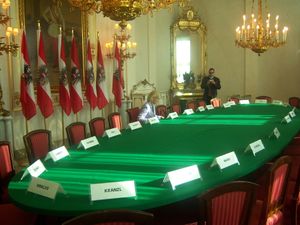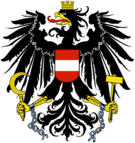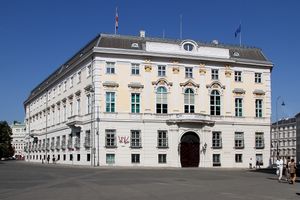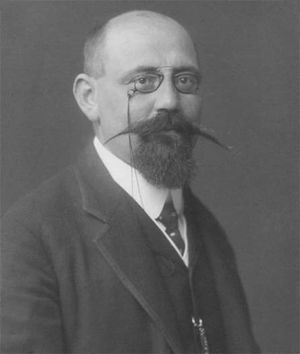مستشار النمسا
| ||||||||||||||||||||||||||||||||||||||
| ||||||||||||||||||||||||||||||||||||||
المستشار الاتحادي للنمسا (ألمانية: Bundeskanzler، ويُختصر أحياناً إلى كانتسلر Kanzler)، هو رئيس حكومة جمهورية النمسا. ضمن سلطته كرئيس للحكومة الاتحادية النمساوية، يمثل المستشار السلطة الاتحادية العليا للسلطة التنفيذية.
على الرغم من كونه عضواً رسمياً في مجلس الوزراء، إلا أن مستشار النمسا يعتبر أكثر المناصب نفوذاً في السياسة النمساوية، ويعتبر رئيساً فعلياً للسلطة التنفيذية. مقره الرسمي في المستشارية الاتحادية.
المستشارا لنمساوي الحالي هو كارل نيهامر، والذي تولى المنصب منذ 6 ديسمبر 2021.[1]
The chancellor's place in Austria's political system
Austria's chancellor chairs and leads the cabinet, which is composed of the chancellor, the vice chancellor and the ministers. Together with the president, who is head of state, the cabinet forms the country's executive branch leadership.
Austria is a parliamentary republic, the system of government in which real power is vested in the head of government. However, in Austria most executive actions of great extent can only be exercised by the president, upon advice or with the countersignature of the chancellor or a specific minister. Therefore the chancellor often requires the president's consent to implement greater decisions. Neither the ministers nor the vice chancellor report to the chancellor.
In legislature, the chancellor's power depends on the size of their affiliated parliamentary group. In case of a coalition cabinet, the chancellor commonly is the leader of the party most represented in the National Council, with the leader of the party able to grant a majority, usually serving as the vice chancellor.
The first Austrian sovereign head of government was the State Chancellor of the Austrian Empire, a position only held by Klemens von Metternich. The office was later renamed to Minister-President of the Austrian Empire and remained from there on until the dissolution of Austria-Hungary. The first head of government after the monarchy was the State Chancellor of German-Austria, an office again only held by one person; Karl Renner. After allied powers declined a union between Austria and Germany, the office was renamed to just State Chancellor of Austria and later changed to Federal Chancellor, which remained the position's final form until present day.
The official residence and executive office of the chancellor is the chancellery, which is located at the Ballhausplatz in the center of Vienna. Both the chancellor as well as the cabinet are appointed by the president and can be dismissed by the president.
The current officeholder is Karl Nehammer, who was sworn in as chancellor on 6 December 2021 by President Alexander Van der Bellen.
التاريخ
The use of the term Chancellor (Kanzler, derived from لاتينية: cancellarius) as head of the chancery writing office can be traced back as far as the 9th century, when under King Louis the German the office of the Archchancellor (Erzkanzler), later Imperial Chancellor (Reichserzkanzler), was created as a high office on the service of the Holy Roman Emperor.[2] The task was usually fulfilled by the Prince-Archbishops of Mainz as Archchancellors of the German lands.
In the course of the Imperial reform, the Habsburg Emperor Maximilian I in 1498 attempted to counter the spiritual power of the Reichserzkanzler with a more secular position of an Imperial Court Chancellor (Hofkanzler), but the two became merged. These were also the times when attempts were made to balance Imperial absolutism by the creation of Imperial Governments (Reichsregiment), ultimately a failure.
ملكية هابسبورگ
Nevertheless, when Maximilian's grandson Ferdinand I succeeded him as Archduke of Austria in 1521, his elder brother Emperor Charles V (1519–1556) appointed Mercurino Gattinara as "Grand Chancellor of all the realms and kingdoms of the king" (Großkanzler aller Länder und Königreiche). The separate position of an Austrian Court Chancellor appeared as a Österreichische Hofkanzlei around 1526, when the Habsburg monarchy arose with the Bohemian and Hungarian inheritance; it was however once again merged with the equivalent Reichshofkanzlei office of the Holy Roman Empire in 1559.
Upon the 1620 Battle of White Mountain and the suppression of the Bohemian revolt, Emperor Ferdinand II had separate Court Chancelleries established in order to strengthen the unity of the Habsburg hereditary lands. Beside a Bohemian and Hungarian chancellery, he created the office of an Austrian chancellor in Vienna, responsible for the Archduchy of Austria proper (i.e. Upper and Lower Austria) with the Inner Austrian territories and Tyrol. Under Emperor Leopold I (1658–1705) the term again became Hofkanzler with Johann Paul Freiherr von Hocher (1667–1683), and Theodor von Strattman (1683–1693).[3]
The eighteenth century was dominated by Prince Wenzel Anton of Kaunitz-Rietberg (1753–1792), who was Chancellor to four Habsburg emperors from Maria Theresa to Francis II, with the titles of both Hofkanzler and Staatskanzler. He was succeeded by Johann Philipp von Cobenzl (1792–1793), who was dismissed by Emperor Francis II over the Partition of Poland and was succeeded by Johann Amadeus von Thugut (1793–1800). Thugut's chancellorship did not survive the Austrian defeats by the French at the battles of Marengo and Hohenlinden in 1800 and he was replaced by Johan Ludwig Joseph Cobenzl (1800–1805), his predecessor's cousin, but who in turn was dismissed following the Austrian defeat at Austerlitz in 1805.
الامبراطورية النمساوية
With the consequent dissolution of the Holy Roman Empire and founding of the Austrian Empire, Francis II abdicated the former Imperial Throne, but remained Emperor Francis I of Austria in 1806. He had replaced Cobenzl with Johan Philip Charles Stadion (1805–1809) the previous year, but his career was in turn cut short in 1809 following yet another Austrian defeat by Napoleon at the Battle of Wagram and subsequent humiliation at the Treaty of Schönbrunn. Prince Klemens von Metternich was appointed by Francis I to the positions of Hofkanzler and Staatskanzler (1821–1848). However, there is some opinion that the Chancellor title was not used between Prince Kaunitz-Rietberg's resignation in 1792 and 1821.[4] As the Metternich system had become a synonym for his reactionary politics, the title of a State Chancellor was abolished upon the 1848 revolutions. The position became that of a Minister-President of Austria, equivalent to Prime Minister, with the exception of Count Friedrich Ferdinand von Beust (1867–1871)[3][5] the title only re-emerging at the birth of German Austria after World War I in 1918, when Karl Renner was appointed Staatskanzler. With the enactment of the Constitution of Austria on 10 November 1920, the actual term Bundeskanzler was implemented as head of the executive branch of the First Austrian Republic.[بحاجة لمصدر]
التعيين
يتم تعيين المستشار ويحلف اليمين أمام رئيس النمسا.[6] نظرياً، يمكن للرئيس تعيين أي شخص مؤهل ليتم انتخابه من قبل الملجس الوطني، أي مواطن نمساوي أكبر من 18 سنة.[7] عملياً، لا يمكن للمستشار ممارسة مهام منصبه ما لم يحصل على تصديق من المجلس الوطني. لهذا السبب، فعادة ما يكون المستشار زعيم أكبر حزب في المجلس الوطني، أو زعيم حزب مشارك في تحالف حاكم. ومن أشهر الاستثناءات تلك التي حدثت بعد انتخابات 1999. فاز حزب الحرية بغالبية المقاعد ودخل في تحالف مع حزب الشعب. في الوقت الذي كان يتوجب على يورگ هايدر زعمي حزب الحرية تولي منصب المستشار، فإن كونه عضواً في مجلس الوزراء كان أمراً مثيراً للجدل، ناهيك عن كونه مستشاراً. من ثم فقد تولى ڤولفگانگ شوسل، زعيم حزب الشعب منصب المستشار.
المهام والسلطات

يرأس اجتماعات الحكومة النمساوية لكن ليس له سلطة تكليف وزراء الاتحادية الأخرى. فهو ليس رئيسا للدولة، ولا هو القائد الأعلى للقوات المسلحة النمساوية. وينهض كل من الأدوار مع الرئيس الاتحادي. ولا يمكن للمستشار لا تعيين ولا اقالة وزراء اتحادية أخرى. يمكنه إلا أن يوصي مثل هذا العمل إلى رئيس الاتحادية، الذي قد يعين بعد ذلك أو إقالة وزير. ومع ذلك ، فقد أصبح بحسب الدستور الدستور للعمل مستشارا لرئيس الجمهورية. وعلاوة على ذلك المستشار عادة يرأس أيضا إحدى الوزارات الاتحادية. وهكذا، على الرغم من اعتبار الموقف السياسي الأكثر نفوذا في النمسا، لديه مكانة أضعف بكثير من رئيس الولايات المتحدة أو رئيس وزراء المملكة المتحدة.
السلطة السياسية للمستشار مستمد أساساً من سلطته في حزبه السياسي، والتي يترأسها عادة، ويمكن أن يختلف كثيرا بالاعتماد على ما إذا كان هناك تحالف أو حكومة الحزب الواحد. عادة المستشار هو زعيم أكبر حزب في البرلمان النمساوي، ولكن الرئيس الاتحادي حر في تعيين أي شخص آخر أيضا. في عام 2000 عين الرئيس الاتحادي فولفغانغ شوسيل على الرغم من أن حزبه ثم كان فقط 3 في الانتخابات السابقة.
قائمة مستشار النمسا
المستشارون السابقون الأحياء
المستشارون النمساويون السابقون الستة الأحياء:
- المستشارون النمساويون السابقون الأحياء
فرانتس فرانيتسكي
(1986–1997)
4 أكتوبر 1937ڤيكتور كليما
(1997–2000)
4 يونيو 1947ڤولفگانگ شوسل
(2000–2007)
7 يونيو 1945ألفرد گوزنباير
(2007–2008)
8 فبراير 1960ڤرنر فايمان
(2008–2016)
4 مايو 1960كريستيان كرن
(2016–2017)
4 يناير 1966
انظر أيضاً
- سياسة النمسا
- دستور النمسا
- حكومة النمسا
- قائمة مستشاري النمسا
- نائب مستشار النمسا
- المستشارية الاتحادية النمساوية
- رئيس النمسا
المصادر والهوامش
- ^ Politico (17 December 2017). "Sebastian Kurz gets approval for coalition with Austrian far right".
- ^ "Interdisziplinärer Arbeitskreis Kurmainz und der Erzkanzler des Reiches: Reichserzkanzler". Archived from the original on 7 July 2017. Retrieved 20 September 2012.
- ^ أ ب Cambridge Modern History vol xiii 1911. Forgotten Books. 1902. Retrieved 20 September 2012 – via Internet Archive.
- ^ Kaisergruft: Metternich Archived 15 يناير 2012 at the Wayback Machine
- ^ "Austria Forum Web Books Viewer". Archived from the original on 23 September 2015. Retrieved 23 September 2012.
- ^ Bundes-Verfassungsgesetz article 70
- ^ B-VG art. 26
وصلات خارجية
- Official website (بالألمانية)
- مواليد 4 أكتوبر
- مواليد 1937
- سنة الميلاد مختلفة في ويكي بيانات
- شهر الميلاد مختلف في ويكي بيانات
- يوم الميلاد مختلف في ويكي بيانات
- مواليد 4 يونيو
- مواليد 1947
- مواليد 7 يونيو
- مواليد 1945
- مواليد 8 فبراير
- مواليد 1960
- مواليد 4 مايو
- مواليد 4 يناير
- مواليد 1966
- Short description is different from Wikidata
- Articles containing ألمانية-language text
- Pages using Lang-xx templates
- Articles containing لاتينية-language text
- Articles with unsourced statements from August 2021
- Articles with hatnote templates targeting a nonexistent page
- Official website different in Wikidata and Wikipedia
- مستشارو النمسا
- قائمة الموظفين السياسيين في النمسا
- حكومة النمسا
- قوائم رؤساء وزراء
- تأسيسات 1920 في النمسا












